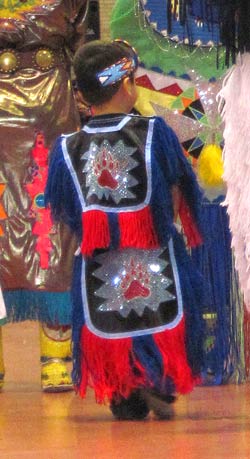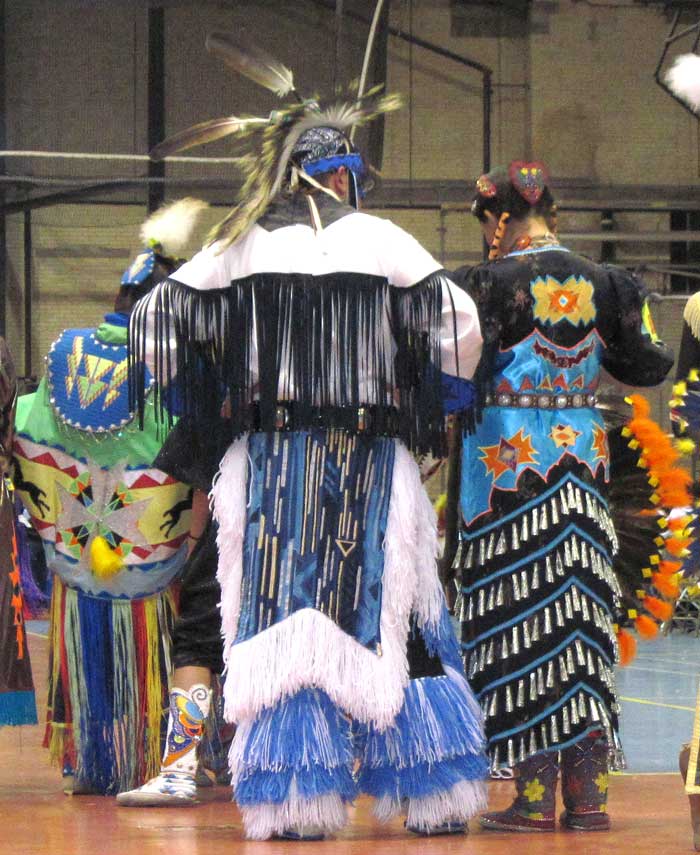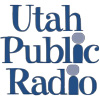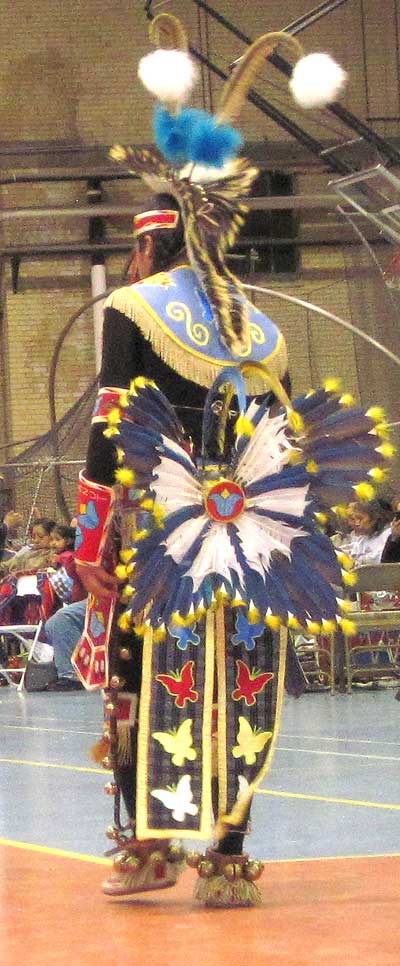38th annual Pow Wow draws hundreds to celebrate Indian culture
March 15th, 2011 Posted in Arts and LifeStory & Photos by Jess Allen
Utah Public Radio Report by Chanae Weller
LOGAN—The Nelson Field House filled with the sound of beating drums and singing as dancers moved to the rhythm. Hundreds watched from the edge of the Pow Wow circle and vendors lined the perimeter of the warm building.
USU’s 38th annual Pow Wow, conducted just before USU’s Spring Break in a March blizzard, was slightly smaller than last year’s event, but the 150 dancers and 12 drum groups more than made up for the weather, said Sandra McCabe, USU Native American Student Council (NASC) president.
• Hear It Now: Click here to listen to a report on the Pow Pow by Utah Public Radio’s Chanae Weller.
• Related story: Navajo student crowned 2011 Miss Indian Utah.
“The storm hit right before the Pow Wow as people were on the way,” said NASC member Alicia Olea, “so they had no choice but to stay where they were as they shut down the highways.”
With dancers in the middle of the circle and the drum groups singing for each dance, the Pow Wow went through three different Grand Entries during the two-day event.
The Field House’s foldout bleachers were packed, as were the tables that lined the back of the building and the foldout chairs that filled the gaps around the circle.
“I just came with my wife,” said sophomore Jordan Morley, 23, as he cut a piece of flat bread with his fork and knife and tried to talk over the echoing drums. “It seemed interesting and it’s been fun.”
Liz Morley, 21, a music theory major, said she attended for one of her classes and was trying to get a taste and better understanding of Native American culture and music.
“I didn’t know about it last year,” Morley said, “and I wish I did. It’s really awesome.”
 With children running around in traditional costume dress, both newcomers and those who have been participating in such gatherings since before they could remember all seemed to agree.
With children running around in traditional costume dress, both newcomers and those who have been participating in such gatherings since before they could remember all seemed to agree.
“I love dancing and having fun and meeting new people,” said Jeremy Garcia-Standing Solider, 19.
Garcia-Standing Solider said he is from the Sioux, Navajo and Sothern Paiute tribes, and has been participating in Pow Wows since he was 9.
Usually competing in the Northern Traditional Dance category, Garcia-Standing Solider said he also had the honor of being chosen by the committee to be this year’s Head Man.
“I have to dance first during the intertribal dance,” he said, “and be a good role model and shake the hands of the other dancers.”
Garcia-Standing Solider said he also got to host a special dance, which he said is something participants can request as a way to honor a people and show respect for a family; it is a way to give back to the Pow Wow circle.
The honor songs at Pow Wows are performed by the host drum group, which has the responsibility of performing all the Grand Entry songs and special-request honor songs.
The Crazy Horse Singers, from Olglala, S.D., were selected by the Pow Wow committee as  the host drummers this year.
the host drummers this year.
Adrian EagleHawk, who said he has been singing at Indian events since he was 3 or 4, said the Crazy Horse Singers are well known, and have been performing for a long time, usually at Pow Wows in the spring or fall.
“If you can get a big, well known drum group, people will be attracted to it,” McCabe said. “So it’s kind of like a concert where you have someone who’s well known.
“If they see that it’s going to be a good drum group they know the songs are going to be good and they’re going to want to compete for those.”
Utah Public Radio
NASC Annual Pow Wow
UPR Report by Chanae Weller
Transcription by Whitney Mendivil
 Utah State University is the site of an annual Pow Wow each spring. Event participants compete for showmanship and cash awards. UPR’s Chanea Weller reports.
Utah State University is the site of an annual Pow Wow each spring. Event participants compete for showmanship and cash awards. UPR’s Chanea Weller reports.
The Native American Student Council of Utah State University hosted the 38th Annual Pow Wow. Individuals and families across the state and country participated in a rich heritage of dancing and drumming competitions.
Sandra McCabe is President of the Native American Student Council. “It’s a cultural celebration and it’s also a dance competition amongst young children, teenagers, adults female and males that are competing against each other and also the dances that they do are actually symbolic.”
Drum beats shook the floor for two days as tribal dress performers danced in the categories of golden age, jingle, grass, fancy, tiny-tots and traditional. Each dance claimed its own rhythm and movement depending on the dancer.
 Logan Reader of the Kiowa and Wichita tribes danced to the men’s fancy. “A men’s fancy is really quick. What the judges look for is if you keep up with the drum. Sometimes it becomes a battle between the dancer and the drum. It can get a little out of hand sometimes; sometimes it’s a little too fast. Judges look for footwork, making sure you’re keeping time. And also just your overall style, everyone doesn’t dance the same. If you really pay attention you can see the different movements. Some people might move their shoulders more other people might be more footwork or more spinning. It’s all preference.”
Logan Reader of the Kiowa and Wichita tribes danced to the men’s fancy. “A men’s fancy is really quick. What the judges look for is if you keep up with the drum. Sometimes it becomes a battle between the dancer and the drum. It can get a little out of hand sometimes; sometimes it’s a little too fast. Judges look for footwork, making sure you’re keeping time. And also just your overall style, everyone doesn’t dance the same. If you really pay attention you can see the different movements. Some people might move their shoulders more other people might be more footwork or more spinning. It’s all preference.”
Not only is the foot movement crucial to the dance, but also the appearance. Many dancers dressed in intricate hand-sown and beaded clothing which held significant symbolism.
Logan: “Just by looking at the feathers that the men’s fancy wear on their head you see the traditional dancers and the grass dancers will sometimes use the spinner where the eagle feathers will rotate in a circular motion. The story behind the two feathers on the top is that they face the same direction they go in a rocking motion back and forth. The men’s fancy dance used to be a war dance and the feathers on top used to simulate two warriors fighting against each other and the faster you rocked it the harder they were fighting.”
Drummers drum and the dancers dance while families enjoy the smell of fried bread and watch jewelry vendors as they handcraft beaded necklaces, bracelets and clothing. For dancers Logan, Marcus and Dwight, the purpose for going to these Pow Wows is personal.
Logan: “The people, I have seen people who have actually traveled from Canada here. And I was really surprised, man I wouldn’t think anyone would come this far. People form Browning, which is just right by the Canadian border. And I got locals like myself coming it’s really great to see everyone showing up. A lot of these people I have seen around and it’s good to see them again.”
Marcus: “My favorite part is that everyone is doing a good time dancing and trying to win money and all that.”
Dwight: “What I like about it is that its seven minutes away from my house that’s because we go to a lot of places like Montana and Washington. And also since I live here a few of my friends come here and it’s a little embarrassing and weird seeing their reaction when I dance and stuff. It’s just really fun.”
Pow Wows are held every weekend across the country. A few of the upcoming Pow Wows this week will be in Florida, Arizona, Washington, and Texas. Reporting from Logan, this is Chanae Weller with Utah Public Radio.
TP
Tags: NASC, Native Americans, Pow Wow, tribes


1 Trackback(s)
Sorry, comments for this entry are closed at this time.